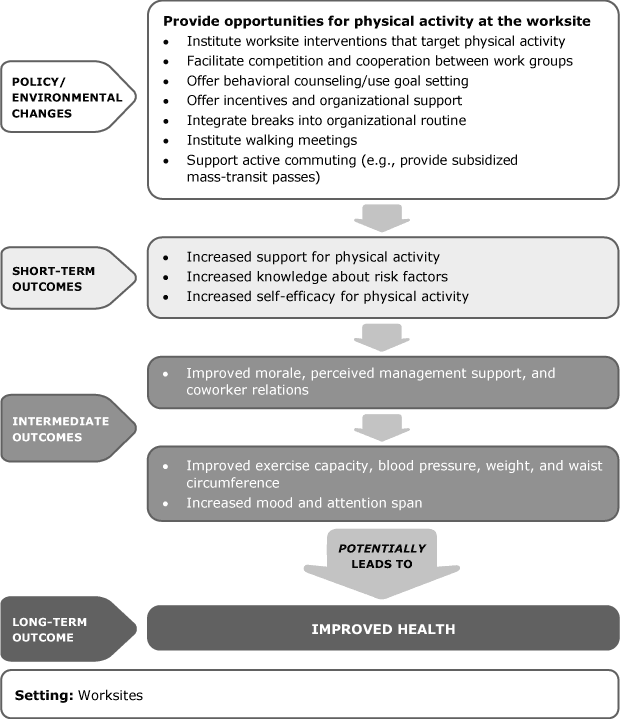Our Healthier Communities
Our Healthier Communities Initiatives are built on the concept that local communities can work together to give all community members healthy choices and support the pursuit of healthy lifestyles. More than 160 Ys are working in collaboration with community leaders to make changes in policies and the physical surroundings in those communities so that healthy living is within reach for individuals of all ages and backgrounds.
Provide Opportunities for Physical Activity at the Worksite
Motivating employees to participate in physical activity can effect positive behavior change and potentially improve overall workforce health. Worksite interventions targeting physical activity have been shown to be the most effective.
Interventions targeting physical activity specifically have been shown to be the most effective worksite interventions. Worksite interventions use team competition, goal setting and behavioral counseling as mechanisms for motivating behavior change. Although worksite interventions face challenges such as motivating participants to register for the program, retaining participation and long-term maintenance of positive behavior change, a literature review shows modest effects in weight loss at 6–12 months, increases in moderate to vigorous physical activity and reductions in cardiovascular risk factors. Other innovative ideas, such as integrating work breaks, even as short as 10 minutes, have resulted in meaningful health benefits. These strategies are well received individually and organizationally and have the potential to improve the health of the workforce.
References
- Anderson, L.M., Quinn, T.A., Glanz, K., Ramirez, G., Kahwati, L.C., Johnson, D.B., & Katz, D.L. (2009). The effectiveness of worksite nutrition and physical activity interventions for controlling employee overweight and obesity: A systematic review. American Journal of Preventive Medicine, 37(4), 340–57.
- Dishman, R.K., DeJoy, D.M., Wilson, M.G., & Vandenberg, R.J. (2008). Move to improve: A randomized workplace trial to increase physical activity. American Journal of Preventive Medicine, 36(2), 133–141.
- Gomel, M., Oldenburg, B., Simpson, J.M., & Owen, N. (1993). Work-site cardiovascular risk reduction: A randomized trial of health assessment, education, counseling, and incentives. American Journal of Public Health, 83(9), 1231–1238.
- Healthy Eating Active Living Cities Campaign. (n.d.). Be a city with a healthy workforce. Retrieved November 15, 2010, from http://www.healcitiescampaign.org.
- Pedersen, M.T., Blangsted, A.K., Andersen, L.L., Jorgensen, M.B., Hansen, E.A., & Sjogaard, G. (2009). The effect of worksite physical activity intervention on physical capacity, health, and productivity: A 1-year randomized controlled trial. Journal of Occupational and Environmental Medicine, 51(7), 759–770.
- Pegus, C., Bazzarre, T., Brown, J., & Menzin, J. (2002). Effect of the Heart At Work Program on awareness of risk factors, self-efficacy and health behaviors. Journal of Occupational and Environmental Medicine, 44(3).
- Pressler, A., Knebel, U., Esch, S., Kolbl, D., Esefeld, K., Scherr, J., Haller, B., Schmidt-Trucksass, A., Krcmar, H., Halle, M., & Leimeister, J.M. (2010). An internet-delivered exercise intervention for workplace health promotion in overweight sedentary employees: A randomized trial. Preventive Medicine, 51, 234–239.
- Stunkard, A.J., Yopp Cohen, R., & Felix, M.R.J. (1989). Weight loss competitions at the worksite: How they work and how well. Preventive Medicine, 18, 460–474.
- Yancey, A. (2009). Integrating physical activity and healthy eating into organizational routine. In UCLA Kaiser Permanente Center for Health Equity, Presentations. Retrieved November 15, 2010, from http://healthequity.ucla.edu.

More Healthy Living Strategies
-
Active Living Strategy #8
Healthy Living Strategies
-
Active Living Strategy #9
Healthy Living Strategies
-
Active Living Strategy #10
Healthy Living Strategies